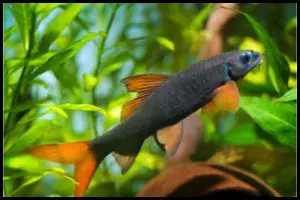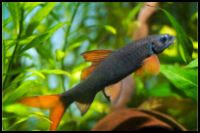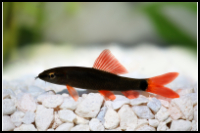



Quick Care Details (Table)
| Livestock Characteristics | Value |
|---|---|
| Care Level | Moderate |
| Temperament | Semi-Aggressive |
| Diet | Omnivore |
| Maximum Size | 6 Inches |
| Minimum Tank Size | 50 Gallons |
| Plant Safe | Yes |
| Temperature Range | 72-80F |
| PH Range | 6.5-7.5 |
| KH Range | 10-15 |
Species Specific Categories
Helpful Video
Care Details
Aquascape: Picture your aquarium as their home sweet home. Rainbow Sharks are a bit territorial, so set up their space with lots of caves, driftwood, and rocks. Live or fake plants add a nice touch, offering both shelter and visual appeal.
Substrate: Think of it as their cozy carpet. A fine gravel or sand bed works well since Rainbow Sharks often hang out near the bottom. Plus, it's easier on their delicate bellies.
Disease Prevention: Keep their digs clean! Regular water changes are like a breath of fresh air. Quarantine any newcomers to the tank to prevent potential sickness from spreading.
Filtration: Your filtration system is like their personal butler, making sure the place stays tidy. Invest in good mechanical and biological filtration for top-notch water quality.
Lighting: While they're not too picky about lighting, decent illumination is a must for their habitat. If you're into live plants, make sure the lighting supports their growth.
Water Flow: Rainbow Sharks prefer a gentle to moderate water flow. It's like a lazy river, creating a comfy living space.
Hardiness: These guys are quite adaptable, suitable for both rookie and seasoned aquarists. Just keep their water conditions steady.
Acclimation: Introduce them to their new pad slowly with the drip acclimation method. It's like helping them get used to their surroundings at their own pace.
Expected Lifespan: Picture them as long-term roomies. With proper care, they can hang around for 6-8 years or even longer.
Special Requirements: Here's the deal—Rainbow Sharks aren't big on house-sharing. They can get feisty, especially with their own kind. So, if you're planning to have a few under one roof, make sure it's a big house with lots of nooks and crannies.
Temperament and Behavior
Behavior: Rainbow Sharks are like the busybodies of your aquarium, always on the move. They're explorers, constantly checking out their domain. Sometimes they can be a tad territorial, staking claim to their favorite hiding spots. You'll often see them during the day, darting around, investigating everything like curious roommates.
Breeding: Now, the dating scene can be tricky. Breeding Rainbow Sharks in your tank might require a bit of a romantic getaway for them. They can be solitary and sometimes even a bit aggressive during the courtship. So, a separate breeding tank is like a cozy spot for their romantic endeavors.
Aggression: Speaking of temperament, Rainbow Sharks can be a bit feisty, especially with their own kind and fish that look too similar. It's like they have a strict "no look-alike" policy. So, be mindful when adding other bottom-dwelling fish to the mix to avoid territorial clashes.
Tankmates Compatibility: When it comes to making friends, think about inviting some neighbors that prefer the upper and middle levels of the tank. Stay away from other bottom-dwellers, as they might not appreciate the company. Peaceful community fish like tetras or danios can make for great companions, as Rainbow Sharks usually don't bother them.
Activity Level: Rainbow Sharks are the energetic souls in your aquatic household. They love to swim around and explore. Keep them entertained with hiding spots, caves, and a well-structured environment.
Schooling or Shoaling Behavior: They might look like synchronized swimmers, but Rainbow Sharks don't actually shoal. They're more of the lone wolf type, enjoying their own space in the tank.
Plant Compatibility: When it comes to plants, Rainbow Sharks have a bit of a green tooth. They may nibble on live plants, so opt for hardy varieties that can handle their occasional munching. Or, if you want to keep your greenery intact, you can go for artificial plants.
Diet and Nutrition
Dry Foods: Think of dry foods as the trusty staples in your fish pantry. Rainbow Sharks, being the omnivores they are, enjoy high-quality flakes and pellets designed for bottom-dwelling fish. It's like serving them their daily dose of comfort food, providing essential nutrients and keeping them satisfied.
Frozen Foods: Frozen goodies are like the occasional takeout treat for your underwater friend. Offer a variety of frozen options, such as bloodworms, brine shrimp, or daphnia. These protein-packed delights turn mealtime into a gourmet experience, leaving your Rainbow Shark feeling like they've just dined at a fine seafood restaurant.
Live Foods: Live foods are the top-tier delicacies, the caviar of the fish world. Rainbow Sharks relish live prey like blackworms and live brine shrimp. It's akin to treating them to a five-star meal once in a while, complete with a live, wriggling appetizer.
Vegetables: Your Rainbow Shark has a bit of a vegetarian side. Present them with blanched vegetables like zucchini, cucumber, or spinach. It's like serving up a wholesome side dish in their aquatic buffet, ensuring they get their greens.
Algae: Rainbow Sharks fancy themselves as the gardeners of the tank. They'll happily nibble on algae, acting as your very own cleanup crew. It's like having an eco-friendly, built-in algae management system, keeping your tank pristine. Do not as they age they will eat algae less often and at some point might even stop eating algae altogether.
Feeding Schedule: Picture a well-structured mealtime routine, like clocking in for breakfast and dinner. Feed your Rainbow Shark small portions multiple times a day. Their active lifestyle calls for frequent refueling, just like athletes with a busy training schedule.
Supplemental Foods: From time to time, consider adding a dash of excitement to their diet with supplemental foods. Freeze-dried treats or live morsels can add variety and keep things interesting, making mealtime an adventure.
Tank Parameters
Tank Size: When it comes to accommodating your lively underwater buddy, think big. Rainbow Sharks need room to roam, so a spacious 55-gallon tank or larger is the way to go. This provides them with the aquatic playground they need to explore and establish their own territory.
Tank Length and Measurements: Opt for a tank that's around 4 feet in length (about 120 cm). This elongated setup lets your Rainbow Shark stretch its fins, offering ample space to call its own. It's like granting them their own mini-aquatic kingdom.
Water Temperature: To keep your finned friend comfy, maintain the water temperature between 74-79°F (23-26°C). This range is akin to setting your thermostat at the perfect room temperature.
pH (Acidity/Alkalinity): Aim for a slightly acidic to neutral pH level, roughly 6.5-7.5. This mimics their natural waters, making your Rainbow Shark feel right at home.
KH (Carbonate Hardness): Keep the carbonate hardness around 5-15 dKH to ensure a stable aquatic environment that suits their needs.
GH (General Hardness): General hardness should fall within the range of 6-15 dGH, providing the essential minerals your Rainbow Shark craves, reminiscent of their native habitat.
Hardiness: These aquatic companions are known for their durability, making them a fantastic choice for aquarists of all levels. Just remember, stable water conditions are key to their well-being.
Nitrate (NO3) Levels: To keep the water pristine and your Rainbow Shark content, maintain nitrate levels below 40 ppm. Routine water changes are like a refreshing breath of air, ensuring your fish enjoys a clean and healthy aquatic environment.
History, Popularity, History and Species Variety Details
Table of Contents
The History, Popularity and Natural Habitat
History: The Rainbow Shark, known scientifically as Epalzeorhynchos frenatum, hails from Southeast Asia, primarily Thailand. They've been cherished by aquarium enthusiasts for years, adding their vibrant colors and lively personalities to freshwater tanks. In recent years, these striking fish have gained popularity for their unique appearance and active behavior.
Popularity: Rainbow Sharks have become a beloved choice among aquarists due to their striking contrast of jet-black bodies and fiery orange-red fins. Their engaging personalities and algae-eating habits make them a favorite pick for both beginners and experienced fish keepers. Their charm and compatibility with various tank mates contribute to their enduring popularity.
Natural Habitat: In the wild, you'd find Rainbow Sharks in the freshwater rivers and streams of Southeast Asia. Their native habitats are often characterized by rocky riverbeds and plenty of vegetation. These environments have shaped their behaviors and preferences, making them well-suited for aquariums with similar features, like hiding spots and the presence of algae for grazing.
Understanding the history, popularity, and natural habitat of Rainbow Sharks provides insights into why these fish have captured the hearts of aquarium enthusiasts worldwide. Their unique beauty, engaging personalities, and adaptability make them a standout choice for any freshwater tank.
Back to topSimilar Fish to the Rainbow Shark
- Bala Shark (Balantiocheilos melanopterus): Bala Sharks are popular in the aquarium hobby for their sleek, silver bodies and triangular dorsal fins, resembling the shape of a shark's dorsal fin. They are active swimmers and can grow quite large, so they require spacious tanks.
- Iridescent Shark (Pangasianodon hypophthalmus): Also known as the Pangasius or Siamese Shark, these fish can reach substantial sizes and are known for their iridescent scales and elongated bodies. They are not suitable for most home aquariums due to their immense size.
- Red-Tailed Shark (Epalzeorhynchos bicolor): This fish is not a true shark but shares its common name with the Rainbow Shark. Red-Tailed Sharks are known for their striking black bodies and vibrant red tails. They're active swimmers and are often kept in community tanks.
- Silver Apollo Shark (Luciosoma spilopleura): These fish have slender bodies and are named for their silvery appearance and their active, shark-like swimming style. They're less common in the aquarium trade.
- Shark Catfish (Columbian Shark, Liosomadoras oncinus): Shark Catfish, while not resembling sharks in appearance, may be named due to their predatory behavior and streamlined bodies. They are nocturnal and bottom-dwelling fish.

